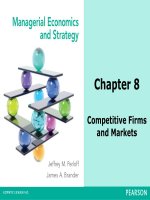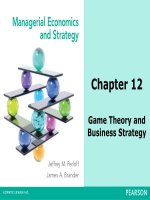Managerial economics 3rd by froeb ch09
Bạn đang xem bản rút gọn của tài liệu. Xem và tải ngay bản đầy đủ của tài liệu tại đây (1.04 MB, 16 trang )
11
Chapter 9
Relationships
Between
Industries: The
forces moving us towards
long-run equilibrium
Copyright ©2014 Cengage Learning. All Rights Reserved. May not be scanned, copied or duplicated, or posted to a publicly accessible website, in whole or in part.
1
Chapter 9 – Summary of main
points
• A competitive firm can earn positive or negative
profit in the short run until entry or exit occurs. In
the long run, competitive firms are condemned to
earn only an average rate of return.
• Profit exhibits what is called mean reversion, or
“regression toward the mean.”
• If an asset is mobile, then in equilibrium the asset
will be indifferent about where it is used (i.e., it will
make the same profit no matter where it goes). This
implies that unattractive jobs will pay
compensating wage differentials, and risky
investments will pay compensating risk differentials
(or a risk premium).
Copyright ©2014 Cengage Learning. All Rights Reserved. May not be scanned, copied or duplicated, or posted to a publicly accessible website, in whole or in part.
Summary of main points
(cont.)
• The difference between stock returns and
bond yields includes a compensating risk
premium. When risk premia become too small,
some investors view this as a time to get out
of risky assets because the market may be
ignoring risk in pursuit of higher returns.
• Monopoly firms can earn positive profit for a
longer period of time than competitive firms,
but entry and imitation eventually erode their
profit as well.
Copyright ©2014 Cengage Learning. All Rights Reserved. May not be scanned, copied or duplicated, or posted to a publicly accessible website, in whole or in part.
Introductory Anecdote: Good to
Great
• In 2001, Jim Collin published Good to Great, a
book detailing how 11 companies used
management principals to go from “good” to
“great”
• By 2009 many of these same companies were
bankrupt – they had done amazingly well during
the research period but failed to outperform the
market after the book’s publication. Why?
• Mr. Collin’s made two fatal errors
• The “fundamental error of attribution”
•
Successful firms aren’t necessarily successful because
of their observed behavior. (this will be discusses in a
later chapter)
• Ignoring long-run forces that erode profit.
•
Competition erodes above-average profit (this will be
discussed in this chapter)
Copyright ©2014 Cengage Learning. All Rights Reserved. May not be scanned, copied or duplicated, or posted to a publicly accessible website, in whole or in part.
Competitive firms
• Definition: A competitive firm is one that cannot
affect price.
• They produce a product or service with
very close substitutes so they have very
elastic demand.
• They have many rivals and no cost
advantage over them.
• The industry has no barriers to entry or
exit.
• Competitive firms,
• cannot affect price; they can choose only how much to
produce
• Can sell all they want at the competitive price, so the
marginal revenue of another unit is equal to the price
(sometimes called “price taking” behavior).
• For competitive firms price equals marginal revenue, so
if P>MC, produce more and if P
Competitive firms (cont.)
• Perfect competition is a theoretical benchmark
• But, many industries come close; and
• The benchmark is valuable to expose the forces that move prices and firm
profit in the long run
• A competitive firm can earn positive or negative profit,
but only in the short-run. In the long run:
• Positive profit (P>AC) leads to entry, decreasing price
and profit
• Negative profit (P
• In the long-run, competitive firms are condemned to
earn only an average rate of return.
• Proposition: In equilibrium, capital is indifferent
between entering one industry or any other, because
P=AC (economic profit is zero)
Copyright ©2014 Cengage Learning. All Rights Reserved. May not be scanned, copied or duplicated, or posted to a publicly accessible website, in whole or in part.
“Mean reversion” of profits
• Asset flows force price to average cost, e.g.
economic profit will always revert back to
zero.
• We say that “profits exhibit mean reversion”
• Silver lining to dark cloud (low profit will
increase as firms exit the industry)
• Discussion: If profits recover, what does this
say about EVA® adoption?
• Reversion speed is 38% per year.
• So, if profits are 20% above the mean one
year, in the next year they will be only 12.4%
above the mean, on average.
Copyright ©2014 Cengage Learning. All Rights Reserved. May not be scanned, copied or duplicated, or posted to a publicly accessible website, in whole or in part.
Mean reversion of profits
Copyright ©2014 Cengage Learning. All Rights Reserved. May not be scanned, copied or duplicated, or posted to a publicly accessible website, in whole or in part.
Indifference principle
• The ability of assets to move from lower- to
higher-valued uses is the force that moves an
industry toward long-run equilibrium.
• Definition: If an asset is mobile, then in long-run
equilibrium, the asset will be indifferent about
where it is used; that is, it will make the same
profit no matter where it goes.
• Discussion: Suppose that San Diego is a lot more
attractive than Nashville. What will happen?
• Discussion: Michael Porter has tried to convince
businesses to re-locate in the inner city. Is this a
good idea?
Copyright ©2014 Cengage Learning. All Rights Reserved. May not be scanned, copied or duplicated, or posted to a publicly accessible website, in whole or in part.
Compensating wage
differentials
• Wages adjust to restore equilibrium
• Discussion: Why do embalmers make more than
rehabilitation counselors?
• Discussion: Give example of a compensating wage
differential.
• Is there a compensating marriage differential--are
women compensated for the relatively unpleasant
task of marriage? (HIINT: what happens to
women’s income when they divorce?) (HINT: what
happens to women’s happiness when they divorce?)
Copyright ©2014 Cengage Learning. All Rights Reserved. May not be scanned, copied or duplicated, or posted to a publicly accessible website, in whole or in part.
Finance: risk vs. return
• Proposition: In equilibrium, differences in the rate
of return reflect differences in the riskiness of the
investment, e.g. risk premium
• Expected return = (E[Pt+1] - Pt)/Pt
• The higher return on a risky stock is known as the
risk premium
• In equilibrium, differences in the rate of return
reflect differences in the riskiness of an
investment.
• Risk premia are analogous to compensating wage
differentials: just as workers are compensated
for unpleasant work, so too are investors
compensated for bearing risk
Copyright ©2014 Cengage Learning. All Rights Reserved. May not be scanned, copied or duplicated, or posted to a publicly accessible website, in whole or in part.
Stock volatility and
returns
•DISCUSSION: VIX measures volatility. Why does higher
volatility lead to lower stock prices? (HINT: investors must be
compensated for bearing risk)
Copyright ©2014 Cengage Learning. All Rights Reserved. May not be scanned, copied or duplicated, or posted to a publicly accessible website, in whole or in part.
•
Historical equity risk
premium
Gov’t bonds are considered risk-free, they return 1.7% while stocks return 6.9%. The difference is a risk premium that compensates investors for holding
the more risky stocks.
• Discussion Why were equity risk premia so small in 2002?
Copyright ©2014 Cengage Learning. All Rights Reserved. May not be scanned, copied or duplicated, or posted to a publicly accessible website, in whole or in part.
Monopoly (different story, same
ending)
•
Definition: A monopoly firm is one that faces a downward
sloping demand curve.
• They produce a product or service with no close
substitutes; they have no rivals; and there are
barriers to entry, so no other firms can enter the
industry.
•
Proposition: In the very long run, monopoly profits are
driven to zero by the same competitive forces.
• Entry makes demand more elastic (P-MC)/P=1/|
e|, which forces price back down towards MC.
• Example: 1983 Macintosh was priced very high
when it first appeared. Eventually, though,
Windows copied the OS, and price was forced
back down.
Copyright ©2014 Cengage Learning. All Rights Reserved. May not be scanned, copied or duplicated, or posted to a publicly accessible website, in whole or in part.
Alternate intro anecdote
• In 1924, Kleenex tissue was invented as a
means to remove cold cream.
• After studying customer usage habits,
however, the manufacturer (Kimberly-Clark)
realized that many customers were using the
product as a disposable handkerchief. The
company switched its advertising focus, and
sales more than doubled.
• Kimberly-Clark built a leadership position by
creating an innovative use for a relatively
common product.
Copyright ©2014 Cengage Learning. All Rights Reserved. May not be scanned, copied or duplicated, or posted to a publicly accessible website, in whole or in part.
Alternate intro anecdote
(cont.)
• As others saw the profits, however, they
moved into the market.
• The managers of the company maintained
profitability through a continuing stream of
innovations and investment in
advertising/promotion
•
•
•
•
Printed tissue in the 1930’s
Eyeglass tissue in the 1940’s
Space-saving packaging in the 1960’s
Lotion-filled tissue in the 1980’s.
• Without this continuing stream of
innovations and brand support, the
product’s profits would have been slowly
eroded away by the forces of competition.
Copyright ©2014 Cengage Learning. All Rights Reserved. May not be scanned, copied or duplicated, or posted to a publicly accessible website, in whole or in part.









